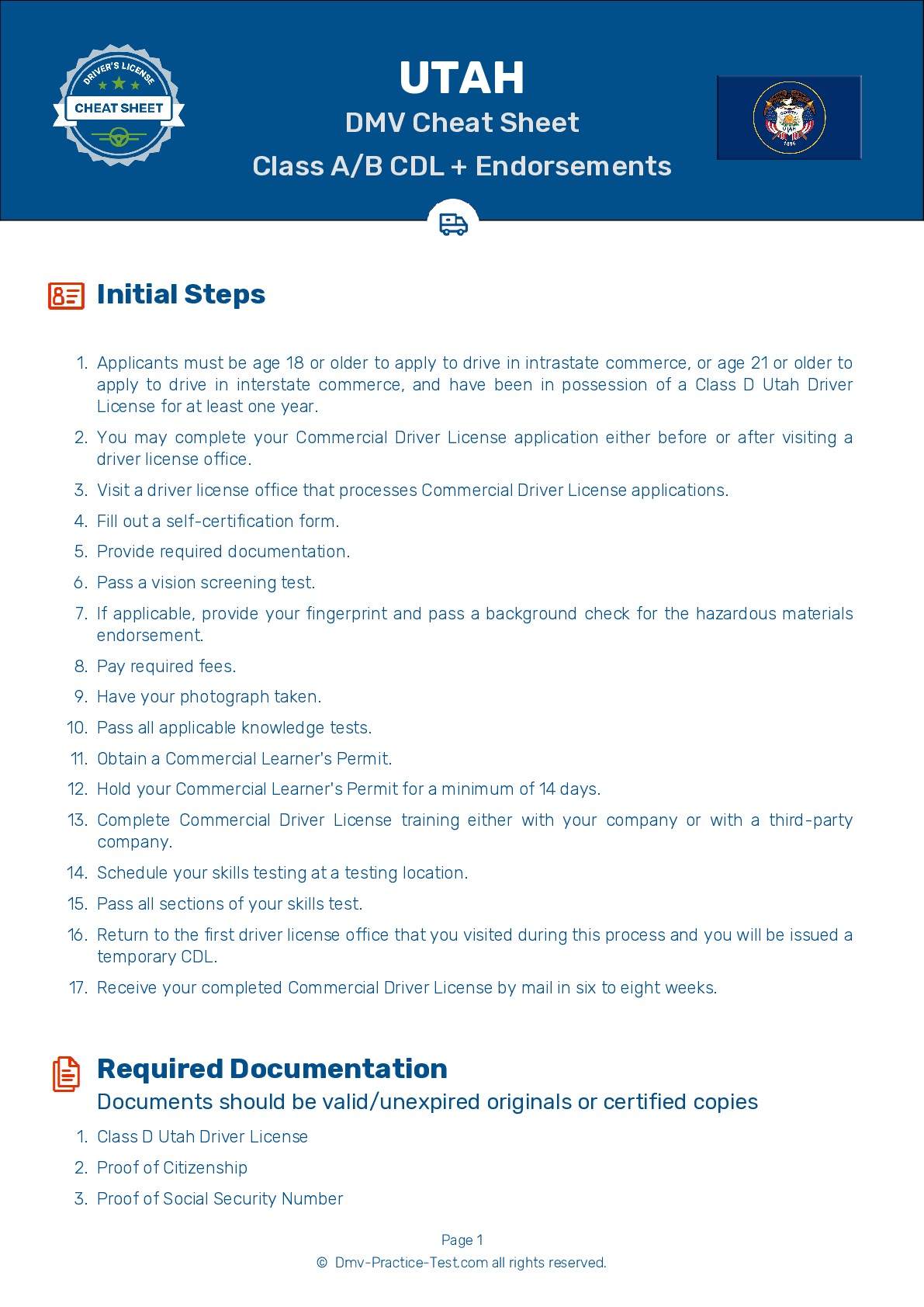HazMat #2
Hazmat Test | Utah 2025 #2 Page 4 of 5
On our website, we provide FREE practice - CDL hazmat test online! The official exam test consists of several obligatory parts, with all of them checking your knowledge of different blocks of road rules. If you need to obtain a UT CDL hazmat endorsement in 2025, practice as much as possible. Free sample tests published on our website will help you check and improve your knowledge and boost your grades. Please bear in mind that Utah requirements for issuing a hazmat endorsement for CDL may vary from those established in other states.
30
24
20
19 . If a shipping paper has both hazardous and non-hazardous materials, the hazardous materials should be:
Written in red ink.
When a shipping paper includes both hazardous and non-hazardous materials, one acceptable method of identifying the hazardous items is to highlight them in a contrasting color.
20 . An explosive material is most likely categorized as a ____ hazard.
Class 7
Class 1 hazardous materials are typically items that present certain explosion or fire hazards.
21 . An improperly placarded vehicle can only be moved:
A vehicle that has not been properly placarded may not be driven, except when necessary to protect life or property in an emergency.
22 . Class 1, Class 2.1, and Class 3 items should not be placed in a trailer with:
Batteries.
The use of cargo heaters is not always permitted. When transporting materials that are categorized as Class 1 (Explosives), Class 2.1 (Flammable Gas), or Class 3 (Flammable Liquids) materials, heaters are generally prohibited.
23 . If a product requires a "Poison Inhalation Hazard" placard, the placard must be used when transporting:
The product in a leaking container.
For applicable materials, the "Poison Inhalation Hazard" placard and the appropriate hazard class placard must always be displayed, even for small amounts of the materials.
24 . A person supervising the loading of a tank:
Must be within 25 feet of the tank.
The loading of a tank with hazardous materials must always be watched by a qualified person. This person must be alert; have a clear view of the tank; stay within 25 feet of the tank; know the hazards associated with the materials; know what to do in an emergency; and be able and authorized to move the tank if necessary.
2025 Utah | Frequently Asked Questions
A CDL Class A license in Utah is defined as a commercial driver's license that allows the holder to operate any combination of vehicles with a gross combination weight rating (GCWR) of 26,001 pounds or more, provided the towed vehicle(s) weigh more than 10,000 pounds. It includes vehicles like tractor-trailers, truck and trailer combinations, and flatbeds.
A Class A CDL license allows you to operate a variety of large vehicles such as tractor-trailers, truck and trailer combinations, tank vehicles, livestock carriers, and flatbeds. This license is also required for operating vehicles that tow trailers or other vehicles with a GVWR of over 10,000 pounds.
To obtain a Class A CDL license in Utah, you must be at least 18 years old for intrastate driving, or 21 for interstate. You need a valid Utah driver’s license, pass a vision exam, and obtain a medical certificate. You must also pass written knowledge tests and a three-part skills test, which includes a pre-trip vehicle inspection, a basic controls test, and a driving test.
In Utah, you must be at least 18 years old to qualify for a Class A Commercial Driver's License (CDL) for intrastate (within the state) driving. However, to drive interstate (across state lines), transport hazardous materials, or drive a school bus, you must be at least 21 years old.
Specific endorsements are not required for a Class A CDL license, but they can provide additional driving privileges. Endorsements include: H (Hazardous Materials), N (Tank Vehicles), P (Passenger Transport), S (School Buses), T (Double/Triple Trailers), and X (Combination of Tank Vehicle and Hazardous Materials). Each endorsement requires passing a specific knowledge test.
The Class A CDL skills test in Utah includes three parts: a pre-trip vehicle inspection, a basic controls test, and a driving test. The pre-trip inspection assesses your ability to inspect your vehicle before driving. The basic controls test evaluates your ability to maneuver and control the vehicle. The driving test evaluates your on-road driving skills.
Yes, limitations can be imposed on Class A CDL license holders in Utah. These restrictions are based on the driver's abilities and the type of vehicle they tested in. For instance, if a driver takes the skills test in a vehicle without air brakes, they will have an "L" restriction, indicating they are not authorized to operate vehicles with air brakes.
In Utah, the written Class A CDL test is primarily offered in English. However, some locations may offer the test in Spanish as well. It's important to note that federal regulations require all commercial drivers to read and speak English sufficiently to converse with the general public, understand highway signs and signals, respond to official inquiries, and make entries on reports and records.
Yes, accommodations can be provided for the Class A CDL written test for individuals with disabilities in Utah. The state complies with the Americans with Disabilities Act (ADA). You'll need to provide documentation of your disability and specify your required accommodation when scheduling your test. It's recommended to contact the Utah Driver License Division for detailed procedures.
Yes, you can retake the Class A CDL written test in Utah if you don't pass it the first time. However, you must wait until the next day to retake it. There's also a retest fee that you'll have to pay each time you retake the test. It's advisable to study thoroughly before reattempting to increase your chances of passing.



